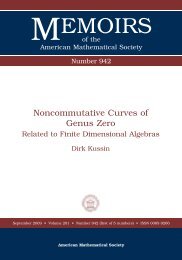University of Paderborn Department of Mathematics Diploma Thesis ...
University of Paderborn Department of Mathematics Diploma Thesis ...
University of Paderborn Department of Mathematics Diploma Thesis ...
You also want an ePaper? Increase the reach of your titles
YUMPU automatically turns print PDFs into web optimized ePapers that Google loves.
118 CHAPTER 4. ALGORITHMS FOR STABLE IDEALS4.7 Computing all Hilbert functions to a given HilbertpolynomialIn this section, we give an algorithm, which uses the non-reduced Hilbert series <strong>of</strong> R/I forI ⊂ R a saturated homogeneous ideal (not necessarily stable), to compute the values <strong>of</strong> theHilbert function h R/I (j). Recall that the Hilbert series <strong>of</strong> R/I is defined to be the formalpower series H R/I (t) := ∑ h R/I (i) · t i . Since the Hilbert series can always be written asi∈Za rational expression <strong>of</strong> the formg(t) for a polynomial g(t) with g(1) ≠ 0 and integer(1 − t)dcoefficients and some d ∈ N, we can use the equationg(t)(1 − t) d = ∑ i∈Zh R/I (i) · t ito determine the values h R/I (i) for each i ∈ Z. Because <strong>of</strong> h R/I (i) = 0 for all i < 0, weonly consider h R/I (i) for i ≥ 0.Remark 4.25. Let I ⊂ R be a saturated homogeneous ideal and H R/I (t) =g(t)(1 − t) the dHilbert series <strong>of</strong> R/I, where g(t) = a 0 + a 1 · t + a 2 · t 2 + . . . + a m · t m , a 0 , a 1 , . . . , a m ∈ Z,m ∈ N 0 , g(1) ≠ 0 and d ∈ N. Then we obtain the values h R/I (i) for all i > 0 from theequationg(t) = (1 − t) d · ∑h R/I (i) · t ias follows: We write (1 − t) d = b 0 + b 1 · t + b 2 · t 2 + . . . + b d · t d with b 0 , b 1 , . . . , b d ∈ Z, b 0 = 1.Since we know that h R/I (0) = 1, we obtain h R/I (i) for i ≥ 1 successively by the equationsh R/I (1) = a 1 − b 1 · h R/I (0)i∈Zh R/I (2) = a 2 − b 1 · h R/I (1) − b 2 · h R/I (0)h R/I (3) = a 3 − b 1 · h R/I (2) − b 2 · h R/I (1) − b 3 · h R/I (0).h R/I (m) = a m − b 1 · h R/I (m − 1) − b 2 · h R/I (m − 2) − . . . − b m · h R/I (0),which provides the first m + 1 values <strong>of</strong> h R/I . For all k > m we compute h R/I (k) byh R/I (k) = −b 1 · h R/I (k − 1) − b 2 · h R/I (k − 2) − . . . − b m · h R/I (k − m).The algorithm to determine the values <strong>of</strong> the Hilbert function h R/I described above is correct,but it lacks elegance: By Theorem 1.7, we know that h R/I (i) = p R/I (i) for all i ≫ 0.If we knew the value <strong>of</strong> some j ∈ N, for which we obtain p R/I (i) = h R/I (i) for all i ≥ j,we could simply determine the value <strong>of</strong> the Hilbert function h R/I (i), i ≥ j, by computing
















